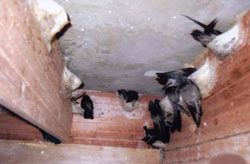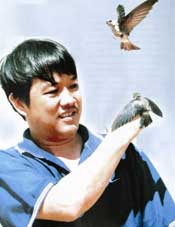The initial successes of machine incubation and healthy breeding of cave-dwelling swallows are opening up prospects for swallow farming as a poultry species in our country.
White Gold
 |
| Model of indoor swallow farming for nest collection (Photo: tchdkh.org.vn) |
The edible and nutritious nests of swallows are found only in Southeast Asia. In our country, the species commonly referred to as cave-dwelling swallows builds nests in caves within limestone mountains along the coastline or on islands. They only feed on flying or living insects and do not consume dead prey. These swallows mate in pairs and construct their nests (bird’s nests) using their saliva, referred to in traditional medicine as “precious saliva” or “mystical nectar.”
The nests weigh about 7 – 15 grams, resembling dried vermicelli strands glued to rock walls. Swallows build their nests from mid-December to early May of the lunar calendar, after which their “precious saliva” dries, preventing further nest construction.
The first harvest of swallow nests occurs in the lunar months of February and March, prompting the swallows to rebuild their nests. The second batch of nests is often smaller, thinner, contains more impurities, and is of lower quality compared to the first batch.
In our country, the areas with the highest concentration of swallow caves are the islands in Nha Trang Bay and nearby regions, Cu Lao Cham near Hoi An, and Phuong Mai Peninsula in Quy Nhon…
Based on color and size, swallow nests are classified into five main types, ranked from highest to lowest value: blood nests (red as blood), pink nests (reddish-orange), white nests (ivory, weighing 8 – 10 grams), dark nests (darker than white nests, weighing 6 – 7 grams), and small nests (weighing 3 – 5 grams).
Additionally, there are also nests from ground swallows (attached to moss), salty nests (soaked in sea moisture), wet nests, thin nests, and nests with impurities…
Currently, our country harvests over three tons of swallow nests annually, with the highest yield from Khanh Hoa (approximately 2 tons/year), Hoi An around 650 kg/year, and Quy Nhon 450 kg/year.
The price for pink and blood nests ranges from $4,000 to over $5,000 per kilogram, but Hoi An has not had these two types of nests for more than ten years, and only a few remain in Khanh Hoa. The wholesale price for small, dark, and white nests ranges from $2,500 to $3,500 per kilogram, depending on the type and origin, with Hoi An’s nests being the most valuable.
Indoor Swallow Farming
Cave-dwelling swallows have a subspecies that nests indoors, which is smaller and has darker feathers than the island swallows. The practice of indoor swallow farming began in the late 19th century in Indonesia. The houses where swallows nest (swallow houses) typically have common characteristics: they are old, have a large space, high humidity, low light, and walls that facilitate nesting…
Indoor farming areas are usually marshy regions with abundant trees and insects, ensuring good ventilation. To attract swallows into the house, the walls, ceilings, and beams are coated with swallow excrement or chemicals that have appealing scents. In swallow houses, during suitable occasions, recordings of natural swallow calls are played to attract flocks and mates…
In Vietnam, there are currently about 20 swallow houses located in Da Nang, Quang Ngai, Phu Yen, Khanh Hoa, Ninh Thuan, Dong Nai, Ba Ria – Vung Tau, Tien Giang, Vinh Long, Bac Lieu, Ca Mau, and Kien Giang. Most owners of these houses, fortunate enough to have swallows residing there, do not interfere with the swallows’ lives and only harvest the nests. Research on actively breeding swallows has only just begun recently.
In Phan Rang – Thap Cham Town (Ninh Thuan), Yen Viet Company has leased the old Thanh Binh theater long-term to maintain the swallow colony that has been there since 1999. The company also acquired three more houses, added artificial nests, and increased humidity to attract the birds.
However, successfully attracting wild swallows into the house is only half the battle. It is not possible to rapidly increase the number of nests in the house if we solely rely on the natural reproduction of the swallows residing there. After many improvements to the incubators imported from Indonesia to better suit the Vietnamese environment, recent hatching batches from Yen Viet Company have achieved a hatching rate of 95%. The survival rate of healthy young swallows here is 50%, with one of their main foods being ant eggs, which staff feed to the young swallows three times a day.
Almost simultaneously with Yen Viet Company, Khanh Hoa Bird’s Nest Company is also researching incubation and artificial breeding of cave-dwelling swallows for nest collection. Since the discovery of the first swallow house on Thong Nhat Street in Nha Trang, which was handed over to Khanh Hoa Bird’s Nest Company for management in early 2004, the company has expanded the swallow colony to three houses, with 282 nests and 950 swallows.
|
|
|
Mr. Vo Thai Lam, Director of Yen Viet Company – a successful indoor swallow farming venture. |
Based on the results of studying the biological behavior of cave-dwelling swallows and experiments in cave swallow farming, the company has developed an incubator for swallow eggs. During the incubation process, parameters such as temperature, humidity, and egg rotation cycles are automatically controlled.
In April 2006, Khanh Hoa Bird’s Nest Company hatched three batches of swallow eggs, achieving a hatching rate of 78.4%. Initially, the young birds raised in the company’s incubators reached a healthy rate of 28%, while reducing the workload for the technicians.
Mr. Le Huu Hoang – Director of Khanh Hoa Bird’s Nest Company stated that the company has established nutritional standards for swallows, allowing for adjustments in the type, amount, and feeding frequency suitable for each group of young swallows. Hundreds of young swallows have been successfully integrated with the natural population in the swallow houses.
“Domestication of cave-dwelling swallows is now within reach” – confidently stated Mr. Vo Thai Lam, Director of Yen Viet Company. He expressed a willingness to share experiences and incubation techniques for indoor swallow farming to help many people prosper.
Yen Viet Company has begun harvesting its first nests to introduce its products to partners. Khanh Hoa Bird’s Nest Company is also refining its incubation and swallow farming processes, as well as establishing a model swallow house in Vietnam for early application and technology transfer. When indoor swallow farming becomes a common profession, there will be no shortage of young swallows, as the natural supply of swallow eggs on the islands is abundant, with many still discarded when harvesting nests.
|
– Bird’s nests are rich in protein, amino acids, and trace elements essential for humans. They stimulate digestion, enhance physical performance and reflexes, regulate the functions of poisoned organs, stabilize hematological parameters, and combat aging… Bird’s nests are also being researched for the treatment of cancer and HIV/AIDS, due to the presence of certain biological compounds that stimulate the growth of peripheral white blood cells. – Indonesia currently has over 10,000 swallow houses, harvesting nests four times a year, with a production of over 100 tons. The production of indoor nests in Malaysia and Thailand also reaches about 15-10 tons/year. Each successful swallow house yields an average of 15-20 kg of bird’s nests per year, with some even reaching up to 50 kg/year. These swallow houses also serve as tourist attractions, drawing many visitors. |



















































